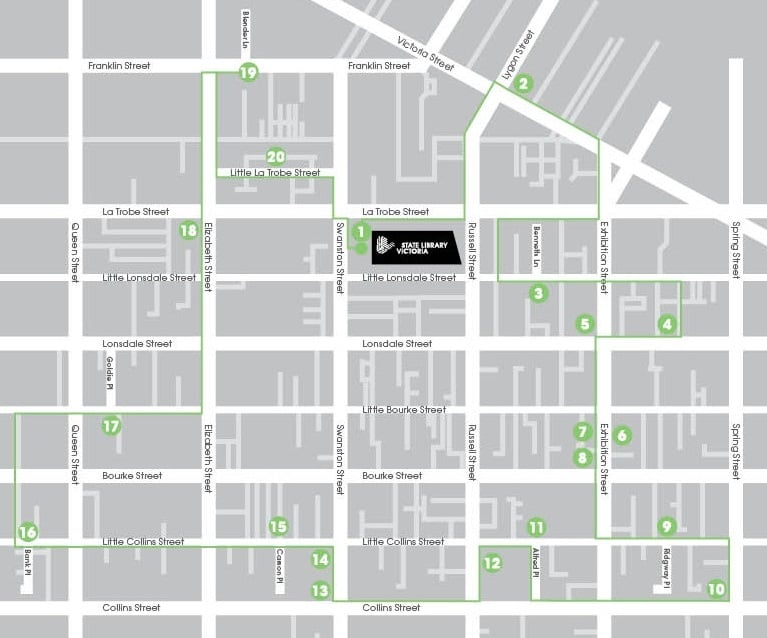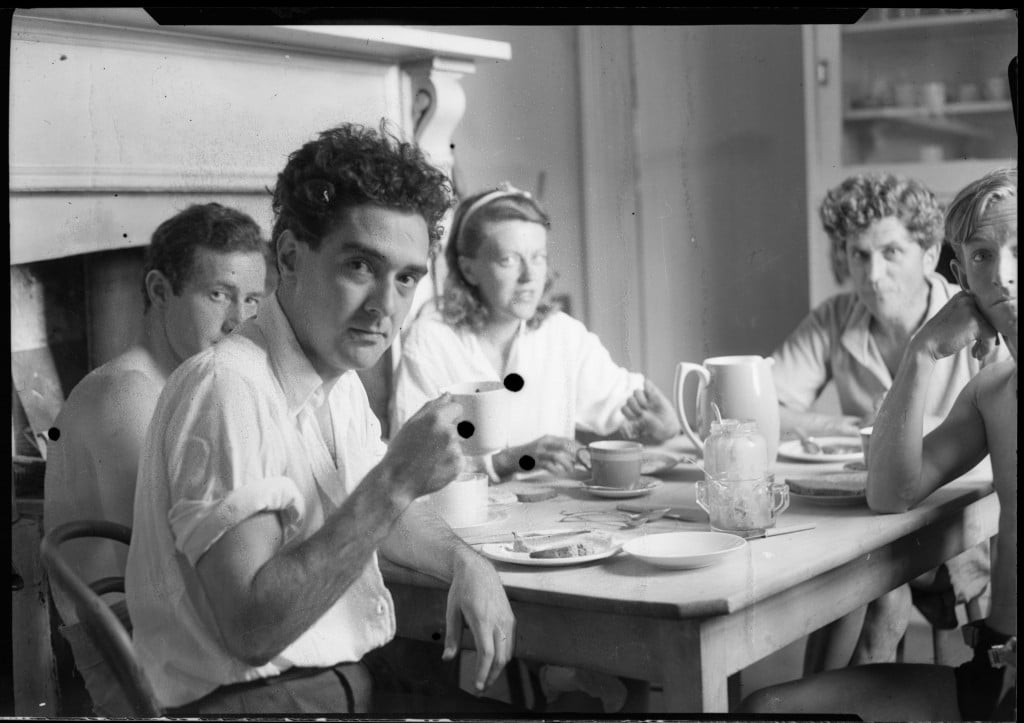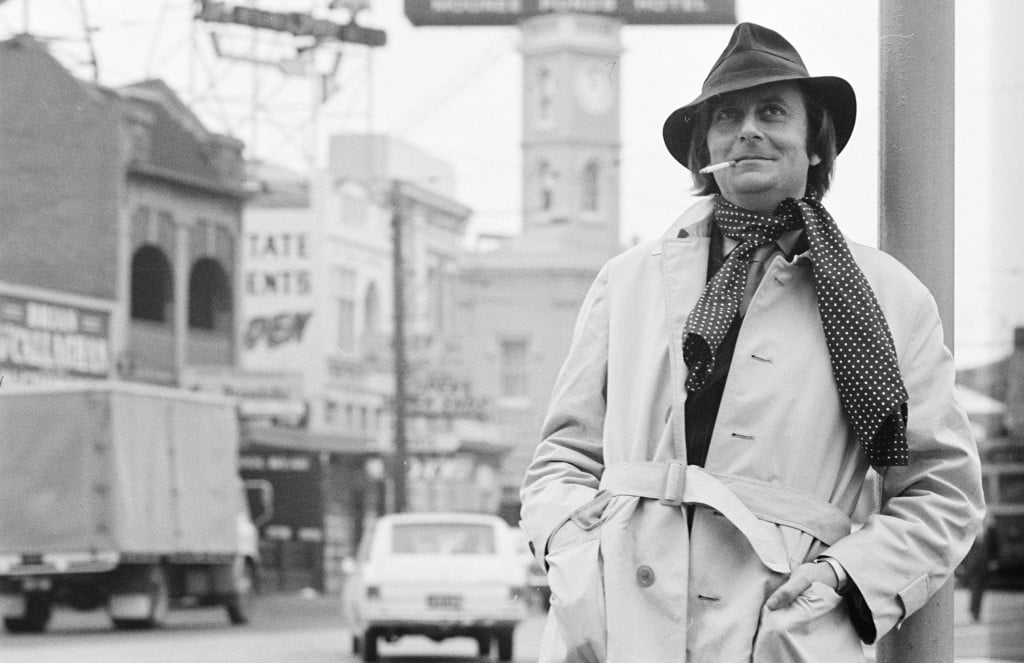Our Bohemian Melbourne walking tours proved very popular, booking out in record time. So to make it possible for everyone to experience a slice of bohemian Melbourne, we have put together this online self-guided version of the tour. We hope you enjoy it!
Stop 1: 328 Swanston Street – State Library Victoria
The State Library was the workplace of writer and librarian Marcus Clarke, generally celebrated as the father of bohemian Melbourne (or its wild child) in the late 1860s and ’70s. Clarke established Melbourne’s first bohemian club, the Yorick.
Stop 2: Corner of Victoria & Lygon Streets – Trades Hall/John Curtin Hotel
Trades Hall has long been a meeting place for the trade union movement, political activists and students. This was a centre for radical bohemians from the 1880s into the 20th century and Carlton bohemia of the 1960s and ’70s.
Stop 3: Opposite Bennetts Lane (off Little Lonsdale Street) – Jazz (Bennetts Lane, Ruby’s and Frank Traynor’s)
In these streets there was once a colourful underworld of Victorian-era opium dens and brothels. Later, great jazz clubs sprang up here, a musical genre with links to counterculture, creativity and free thought.
Stop 4: 50 Lonsdale Street – Madame Brussels Lane
In the late 1800s Madame Brussels was a notorious brothel owner who owned several establishments in this area. Nearby at number 34, the National Press printed literary and artistic avant-garde magazine Angry Penguins in the ’40s.
Stop 5: Corner of Lonsdale & Exhibition Streets
In the early 1900s artists and writers regularly gathered in cafes, restaurants and clubs. Fasoli’s Café (108 Lonsdale Street) was the meeting point of early 20th-century bohemia. The Ishmael Club met regularly at Fasoli’s and included artists and writers such as the Lindsay brothers, who wrote and performed here.
Stop 6: 183 Exhibition Street
Site of Mirka Café, a 1950s centre of cosmopolitan bohemian chic owned by French-born Mirka and Georges Mora. Mirka is a prominent contemporary artist and part of Melbourne’s Heide circle, where she mixed with artists Albert Tucker, Arthur Boyd and Sidney Nolan.
Stop 7: 169 Exhibition Street
Opening here in 1964, Tikki and John’s was a pioneering theatre restaurant and Melbourne institution run by actor Tikki Taylor and showman John Newman. It was home to eccentric performances and raucous celebrations – a fertile breeding ground for aspiring performers.
Stop 8: Corner of Bourke & Exhibition Streets
Screaming fans waved to the Beatles on the balcony of the Southern Cross Hotel here in 1964. Nearby, popular hangouts were restaurants Florentino’s and Pellegrini’s, and the Hill of Content bookstore, frequented by artists Lionel Lindsay, Tom Roberts and Arthur Streeton in the early 1900s.
Stop 9: Ridgway Place
Location of the house shared by Albert Tucker and Joy Hester, modernist artists working from the 1930s on. The two were part of the Heide circle, a likeminded group of artists that frequented the Heidelberg property of patrons John and Sunday Reed (now Heide Museum of Modern Art).
Stop 10: Top of Collins Street – Grosvenor Chambers
Location of the purpose-built artists’ studios occupied by Tom Roberts, Charles Conder and other ‘Heidelberg School’ painters, an art movement of the late 1800s. Here, they hosted ‘conversaziones’ for art lovers and bohemians. Later residents Georges and Mirka Mora were famed for their exuberant parties.
Stop 11: Alfred Place
Frequented by a who’s who of creative types, this was the home of Mietta’s, Melbourne’s great salon of food, wine and entertainment. As well as concerts, it boasted a line-up of incredible chefs, including a young Stephanie Alexander.
Stop 12: Little Collins Street
The location of Café Petrushka, centre of Russophile bohemia in the 1930s, patronised by the likes of writers Hal Porter, Alan Marshall and Alister Kershaw who debated art and ideas here. Russian art and society stimulated a new sense of the avant-garde and possibilities for radical change in Melbourne during this era.
Stop 13: Corner of Swanston & Collins Streets
This was the first home of the left-leaning Argus newspaper and Marcus Clarke’s bohemian Yorick Club. Nearby the Nicholas Building (corner Flinders Lane and Swanston Street) was where renowned artist and dancer Vali Myers had her studio upon returning in 1993 from life overseas.
Stop 14: 123 Swanston Street
In the 1950s Val’s Coffee Lounge was the hip place to be for creatives and the camp crowd. Larger-than-life Val Eastwood decorated it in blue carpet, mauve chairs and raffia lampshades – live music was a regular feature.
Stop 15: Carson Place (off Little Collins Street)
The present-day Butterfly Club is a small theatre and bar that’s home to contemporary burlesque, performance and comedy.
Stop 16: Bank Place
Sites of the Savage Club and the Mitre Tavern – focal points of club and pub bohemia respectively. The Savage Club was founded in 1894 for men interested in art, music, theatre, science and literature. Home to generations of artists and thinkers, it still celebrates its bohemian roots today.
Stop 17: Little Bourke Street – Goldie Place
Location of the Paris Cat jazz venue, a current-day hipster haunt. Jazz may be part of mainstream music now, but 80 years ago conservatives such as J.S. MacDonald, director of the NGV, decried the ‘generation revelling in jazz, jitterbugging … the exalting of the discordant and the ugly’.
Stop 18: Corner La Trobe & Elizabeth Streets
Location of the Argus building and the Duke of Kent Hotel, watering hole of journalists Charmian Clift and George Johnston, who wrote My brother Jack.
Stop 19: Blender Lane (off 100 Franklin Street)
Home of Blender Studios, a current-day creative space and night market for Melbourne’s thriving contemporary street art scene, including artists such as Adrian Doyle.
Stop 20: 50 Little La Trobe Street
Site of legendary late 1960s rock venue The Thumping Tum, reflecting a revolution in Melbourne music that would climax at Sunbury and Mushroom Records and go on to be expressed through punk in the ’70s and ’80s.
Many thanks to author Tony Moore and curator Clare Williamson for their expert insights in creating this tour. We also appreciate the wonderful work of the Bohemian Melbourne walking tour guides Richard Overell, John Arnold and Tony Moore.





This would be awesome if made into a walking app!
Or just a printable version if people are to take it with them out and about.
Good idea! We will look into it. You can open this post on a smartphone/tablet, and pinch and zoom the map, so it would be easy to walk around the city using this post to guide you.
Pingback: Bohemian Melbourne exhibition | The Resident Judge of Port Phillip
Tikki & John’s opened in 163 Exhibition Street in 1964 or 65. Another business occupied 169 Exhibition until 1970 or 71, which is when Tikki & John’s started to advertise from that address. Worth correcting this error?
Love to do the tour I’m a descendant of the famous J J Clark Old Gold Treasury Melbourne City Baths ect his sister Elizabeth Clarke was a painter who went to the Heildleburg School of art
The women where part of the Bohemian group
Of women in Melbourne
Women where sent home on dark , I believe she was a friend of Dame Nellie Melba there was a photo in the Old Gold Treasury